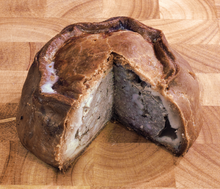Hot water crust pastry
This article needs additional citations for verification. (December 2009) |
 Melton Mowbray pork pie made with hot water crust pastry | |
| Type | Pastry |
|---|---|
| Place of origin | England |
| Main ingredients | Hot water, lard, flour |
Hot water crust is a type of pastry used for savoury pies, such as pork pies, game pies and, more rarely, steak and kidney pies. Hot water crust is traditionally used for producing hand-made pies.
As the name suggests, the pastry is made by heating water, melting the fat in it, bringing the mixture to a boil, and finally incorporating the flour. This can be done by beating the flour into the mixture in the pan, or by kneading on a pastry board. Either way, the result is a hot and rather sticky paste that can be used for hand-raising: shaping by hand, sometimes using a dish or bowl as an inner mould. The molded crust retains its shape as it cools, and is prepared for baking with a filling and additional layer of pastry crust on top. Hand-raised hot water crust pastry does not produce a neat and uniform finish, as there will be sagging during the cooking of the filled pie. This is generally accepted as the mark of a hand-made pie. It is possible, however, to bake the pastry in a mould, as with other pies.
The pastry is often used to make pork pies, and the pastry allows a wet filling to be held in.[1]
See also[]
- List of pastries
- Huff paste
References[]
- ^ Dan Lepard (24 November 2007). "Hot water crust pastry". The Guardian. Guardian News and Media. Retrieved 20 April 2013.
External links[]
| Wikibooks Cookbook has a recipe/module on |
- British cuisine
- Pies
- Pastries
- Doughs
- Pie stubs
- British cuisine stubs